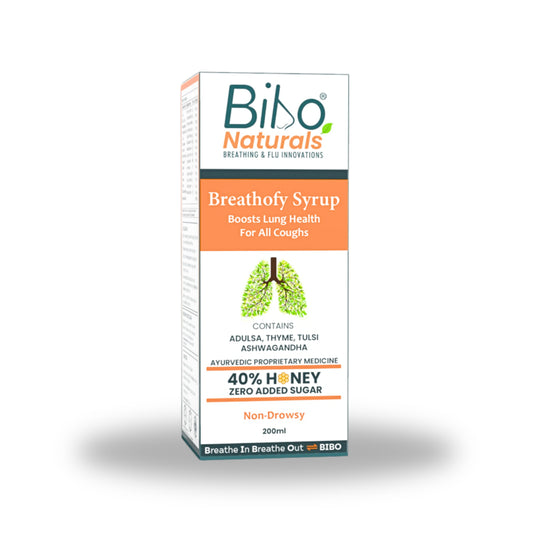
Blog written by: Sourav Pattanayak (M Pharm, MBA)
The plant Tulsi, commonly known as holy basil (Ocimum sanctum), has long been employed in ancient medical practices like Ayurveda. It is well-regarded for its possible health advantages, especially its use in the treatment of respiratory conditions.
Synonyms of Tulsi
Sacred basil, Holy basil
Tulsi's biological source
Ocimum sanctum Linn., a member of the Labiatae family, is the source of both fresh and dried Tulsi leaves.
Chemical constituents
- Its volatile oil content (0.1 to 0.9%) depends upon the geographical area in which the plant is growing and its cultivation season. Steam distillation is used for the volatile oil collection.
- The main chemical constituent present is eugenol, which is approximately 70%.
- 20% methyl eugenol is present in the Tulsi plant.
- Carvacrol is present at approximately 3%.
- Additionally found is caryophyllin. Seeds contain fixed oil, which is ideally suited for drying. Alkaloids, glycosides, saponin, tannins, maleic, citric, and tartaric acids, as well as a considerable amount of vitamin C, are also rumoured to be present in the plant.
Uses of Tulsi
Fresh leaves, their juice, and volatile oil have a variety of applications. Here is a list of them:
- Tulsi oil has both insecticidal and antibacterial effects.
- The leaves are used as an aromatic, stimulant, diaphoretic (producing sweating), and spasmolytic (relieving muscle spasm).
- The juice is used as an earache cure, an antiperiodic, and a component of many medications for treating skin disorders.
- The leaves are infused and used as a stomachic (stimulates appetite).
- The medication is used as a reliable immunomodulatory agent (immune-building).
Uses of Tulsi- as a respiratory care treatment
- Used as an anti-inflammatory agent-The anti-inflammatory ingredients in Tulsi include Eugenol, Rosmarinus acid, and Oleanolic acid. These substances may lessen respiratory system inflammation, alleviating allergies, asthma, and bronchitis symptoms.
- Nasal decongestant and expectorant effect-Due to the expectorant qualities of Tulsi, it can aid in facilitating the ejection of mucus from the respiratory system. Additionally, it could function naturally as a decongestant, easing nasal and pulmonary congestion.
- Used as an antimicrobial agent in respiratory care-Tulsi has antimicrobial qualities that include protection against fungus, viruses, and bacteria. It may lessen the intensity and duration of diseases, including the common cold, the flu, and respiratory tract infections, by assisting in the battle against pathogen-caused respiratory infections.
- Antioxidant effect-Antioxidants including vitamin C, vitamin A, and polyphenols are abundant in Tulsi. These substances assist in preventing oxidative stress and damage brought on by free radicals, which may contribute to respiratory illnesses. Tulsi may contribute to the maintenance of general respiratory health by lowering oxidative stress.
- Used as an immunomodulatory agent-Tulsi contains immunomodulatory properties, which means it can assist in controlling the immune system. For respiratory disorders involving an overactive immune system, including allergic asthma, this characteristic could be helpful. Tulsi may be able to control how the immune system reacts and lessen inflammation brought on by such diseases.
- Stress reduction-Given its reputation as an adaptogen, Tulsi may aid in the body's ability to adjust to stress and restore normal physiological processes. It is said to soothe the nervous system and may lessen tension, anxiety, and mental exhaustion. People frequently drink Tulsi tea or extracts for its calming effects.
How to use Tulsi as an Ayurvedic remedy?
- To eat the plant's fresh leaves, you have to take the fresh leaves of Tulsi and rinse them properly with water to remove the foreign particle. You can then take it directly into your mouth and chew the fresh leaves.
- Alternatively, you can also prepare fresh tea. About 1 tablespoon of fresh Tulsi leaves or 1/3 of Tulsi powder should be added to an open pot of boiling water to prepare Tulsi tea. For 15 to 20 minutes, let the Tulsi powder or leaves steam in the water. Drink this concoction when hot and if needed you can also add honey as a sweetener.
- Tulsi water, consumed first thing in the morning on an empty stomach, helps to wash out all the pollutants. It also aids in digestion and speeds up metabolism due to its strong antioxidant content. When Tulsi is included in one's diet, calories are quickly burned. One of the finest methods to naturally reduce weight and cleanse one’s body is by using Tulsi.
- Take 3 to 4 tablespoons of fresh Tulsi leaves and grind them to extract the fresh juice followed by adding 1 tablespoon of honey into it. Mix it well and take it. It will help as an immunomodulatory, antioxidant, and anti-inflammatory agent.
- You can also use Tulsi as a kadha. You can add 6 to 7 leaves of Tulsi, cinnamon bark, clove, a little amount of ginger and black pepper in fresh water and boil it for 15 minutes. Strain the solution and consume it. You can also use honey as a sweetening agent and lemon as a flavouring agent, as it acts as an antioxidant.
Conclusion
Tulsi promotes respiratory health, making it particularly effective in warding against allergies, colds, and flu. Tulsi is effective at getting rid of foul breath because it aids in lung cleansing. It is one of the best herbs for headaches and fevers and promotes the intestines for good excretion.
References:
1. Cohen MM. Tulsi - Ocimum sanctum: A herb for all reasons. J Ayurveda Integr Med. 2014 Oct-Dec;5(4):251-9. doi: 10.4103/0975-9476.146554. PMID: 25624701; PMCID: PMC4296439.
2. Pattanayak P, Behera P, Das D, Panda SK. Ocimum sanctum Linn. A reservoir plant for therapeutic applications: An overview. Pharmacogn Rev. 2010 Jan;4(7):95-105. doi: 10.4103/0973-7847.65323. PMID: 22228948; PMCID: PMC3249909.
3. Saharkhiz MJ, Kamyab AA, Kazerani NK, Zomorodian K, Pakshir K, Rahimi MJ. Chemical Compositions and Antimicrobial Activities of Ocimum sanctum L. Essential Oils at Different Harvest Stages. Jundishapur J Microbiol. 2014 Dec 6;8(1):e13720. doi: 10.5812/jjm.13720. PMID: 25763132; PMCID: PMC4344766.
4. https://www.pharmacy180.com/article/tulsi-246/





6 comments
Very informative and beneficial. Waiting for your next blog.
Very informative article..it was very useful to me and has enhanced my knowledge alot
Great! It’s extremely informative and very nicely written as well
Amazing content, and very insightful information. Got to know so much about salin and tulsi.
I read this post your post is so nice and very informative post thanks for sharing this post.